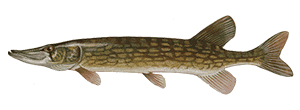Chain Pickerel

Species Details
Esox Niger
Esocidae
Esociformes
Lake, River, Pond, Bogs, Swamps
3 - 5 lbs.
14" - 39"
Chain Pickerel (Esox Niger) Fish Description
Another member of the Pike family, the Chain Pickerel can look quite similar to the Muskellunge. However, Chain Pickerels are smaller than the Muskellunge. They also have fully-scaled cheeks in comparison to the Northern Pike and the Muskellunge. As far as patterns are concerned, Chain Pickerels have a distinct design. Their spotted pattern looks more like a chain hence, the origin of its name.
To some people, from afar, the Chain Pickerel can be mistaken for the Northern Pike.
If you also open the mouth of the Chain Pickerel, they are known to have a very toothy vomer. Their vomer has three strips of teeth, lined up by fours. Their teeth however are not arranged in any linear pattern however and may also be slightly scattered.
Chain Pickerel Diet
Chain Pickerels are fish with an attitude when they get older. While young, they’ll settle for smaller fish. But as they get older, Chain Pickerels are known to get cocky. They’ll eat mice, frogs, crayfish, and a variety of other foods. Their fanged vomer allows them to secure their prey by digging their teeth into their flesh, inflicting grave wounds right away.
Chain Pickerel Size
Chain Pickerels are quite small in comparison to the Muskie and the Pikes. Chain Pickerels barely grow past 2ft. On freak rare occasions, they can grow up to 30 inches. The average size for a full-grown Chain Pickerel however is usually around 24 inches and 3-lbs.
Interesting Facts about the Chain Pickerel
- Chain Pickerel can be eaten. But like the Milkfish, it can have a lot of bones.
- Unless you’re willing to flake them out then, Chain Pickerels is not recommended for children to eat.
- Or, if people start selling Boneless versions of the Chain Pickerel.
- Chain Pickerels, being part of the Pike family, are part of a lay classification known as the Water Wolves.
- Their classification probably comes from being a fierce fighter and opportunistic hunter.
- They are also prone to attacking anything within their vision.
- Chain Pickerels are known for jumping out of the water!
- Chain Pickerels, due to their opportunistic nature, will leap out if they see an insect or a bait that looks easy enough for them to devour.
- A Chain Pickerel’s body is made for an ambush.
- In the northern areas of the Great Lakes, they are considered an invasive species.
Chain Pickerel – Fishing Techniques: How to Fish for a Chain Pickerel
Catching a Chain Pickerel is quite an exciting thing to get into. They’re known for putting up a good fight. As opportunistic fish, anglers usually had success in using live minnows, spinnerbaits, topwater lures, plugs, and flies. They love attacking flashy baits as it reminds them of forage-type fish. Especially if performed with what anglers call the “Figure 8” technique, it’s bound to get them biting. It takes some focus first in putting it out. Once out, make light curves and turns alternating between getting close or drawing it away from the boat.
Despite being lightweight (being only 2-3 lbs), these fish have razor-sharp teeth. Some people recommend using a 12-17 steel test line. What people did notice however is that using Bass techniques work also. Bass Techniques involve jerking the bait a little bit, making it look like injured prey.
Chain Pickerel Habitat and Distribution
Chain Pickerels are found on the eastern coast, near South Canada and Florida, west of Texas. However, many anglers did notice that Chain Pickerels usually congregate in Mississippi Valley. However, they usually appear in Lake Michigan.
Chain Pickerels have a preference for vegetative lakes and swamps. They like slow waters and quiet pools but need the waters to be warm. They prefer waters that are not usually interrupted by the tides or not bothered as much. Interestingly, these Chain Pickerels like acidic waters. They can tolerate waters hitting pH 3.8.







